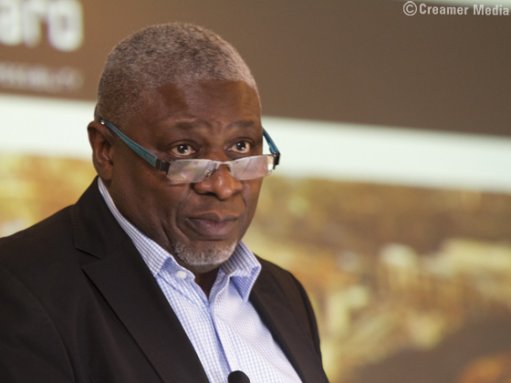
Exxaro CEO Sipho Nkosi
Photo by: Duane Daws
JOHANNESBURG (miningweekly.com) – Underground coal gasification (UCG) holds promise as a future source of energy for South Africa, Exxaro CEO Sipho Nkosi said on Monday.
Nkosi, who hosted a media lunch, told Mining Weekly Online that many companies were investing in UCG, a process of converting coal into gas while it is still underground, or in situ. In some countries, like Canada, UCG is referred to as in situ coal gasification.
In both cases, the process makes use of deep, inaccessible coal that would otherwise remain unused in the ground and is seen as a way of reducing fatalities in coal mining and minimising environmental impact.
The potential is to use the synthetic gas (syngas) that the UCG process provides for the generation of electricity or the production of gas-to-liquids (GTL), chemicals and fertilisers.
There have been many UCG trials in the last few years in the US, Australia, South Africa, Canada and Europe, with a consequent step-change in UCG development towards commercialisation.
“It’s still work in progress,” Nkosi told Mining Weekly Online.
Exxaro, which has a UCG project, has teamed up with UCG technology provider Linc Energy of Australia, which already owns and operates a commercial UCG operation in Uzbekistan, which supplies syngas to the nearby Angren power station.
Eskom has been researching and developing UCG at Majuba for the last six years; Anglo American Thermal Coal has a project and former Sasol executives Johan Brand and Eliphus Monkoe are intent on going ahead with a UCG project in Theunissen, in the Free State.
UCG potential is also said to exist in Botswana, Mozambique and even Namibia.
Exxaro announced earlier this year that it had agreed to pay Linc Energy a A$20-million licence fee in return for the right to deploy the ASX-listed company’s UCG technologies across sub-Saharan Africa.
Formal agreements, subject to several conditions, also gave Linc the option to secure equity positions of up to 49% in all of Exxaro’s UCG projects.
Linc Energy will hold a minimum of 15% in the first project, which could combine power generation and GTL production.
The Linc tie-up opens the way for the start of detailed project work to monetise the perceived inherent value in this clean-coal technology.
The electricity-generating potential of the first plant would not be smaller than 200 MW. Any GTL facility would have a capacity of greater than 10 000 bbl/d.
The bankable feasibility study will be completed by mid-2015, with commissioning of the first gasifier scheduled for mid-2016, subject to regulatory and commercial viability.
Advances in horizontal and directional drilling allow coal seams to be accessed more efficiently, improved monitoring provides more accurate site measurement and better coal ignition technologies are enhancing UCG’s potential.
Detailed UCG legislation is being formulated in Canada’s Alberta province to accommodate the privately owned Swan Hills Synfuels demonstration project there.
It has also commissioned the world’s only combined GTL and UCG demonstration facility, in Queensland, Australia.
The agreement follows on from initial joint concept studies conducted over the past 18 months and will seek to blend Exxaro’s aspiration to pursue coal beneficiation with Linc Energy’s UCG know-how.
Exxaro, which is South Africa’s second-largest coal producer, with current production of 40-million tons a year, also has business interests in Botswana and the Republic of Congo.